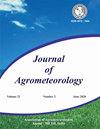Impact of foliar spray of agrochemicals on biophysical parameters, PAR interception and heat use efficiency of mungbean (Vigna radiata (L.) Wilczek) under variable sowing dates in Punjab, India
Q3 Agricultural and Biological Sciences
引用次数: 0
Abstract
A study was carried out during kharif season of 2022 and 2023 at the Punjab Agricultural University (PAU)-Regional Research Station (RRS), Ballowal Saunkhri (SBS Nagar) with the objective to find out the impact of foliar spray of agrochemicals on biophysical parameters, PAR interception and heat use efficiency of rainfed mung bean (Vigna radiata (L.) Wilczek) under variable sowing dates. Timely sown crop (second fortnight of July) resulted in higher leaf area index, chlorophyll index, PAR interception and heat use efficiency (HUE) as compared to late sowing (first fortnight of August). Significantly higher seed yield, stover yield and biological yields were obtained in timely sowing during both the years of study. Foliar spray of KNO3 @ 1.5% recorded significantly higher leaf area index, chlorophyll index, PAR interception, heat use efficiency (HUE) and helio-thermal use efficiency (HTUE) but it was statistically similar with foliar spray of N:P:K (20:20:20) @ 1.5%. Foliar spray of KNO3 @ 1.5% and N:P:K (20:20:20) @ 1.5% gave statistically similar seed, stover and biological yields and significantly better than other treatments. There was an increase of 33.3% in seed yield with foliar spray of KNO3 @ 1.5% and increase of 29.1% with foliar spraying of N:P:K (20:20:20) @ 1.5%, when compared with control.印度旁遮普省不同播种期绿豆(Vigna radiata (L.) Wilczek)叶面喷洒农用化学品对其生物物理参数、PAR 截获和热量利用效率的影响
旁遮普农业大学(PAU)-区域研究站(RRS)在 2022 年和 2023 年的收获季节在 Ballowal Saunkhri(SBS Nagar)进行了一项研究,目的是了解在不同播种期下叶面喷洒农用化学品对雨养绿豆(Vigna radiata (L.) Wilczek)的生物物理参数、PAR 截获和热利用效率的影响。与晚播(8 月的第一个双周)相比,适时播种(7 月的第二个双周)的作物叶面积指数、叶绿素指数、PAR 截获量和热利用效率更高。在这两年的研究中,适时播种获得的种子产量、秸秆产量和生物产量都显著较高。叶面喷施 1.5% 的 KNO3 可显著提高叶面积指数、叶绿素指数、PAR 截获率、热利用效率(HUE)和日光热利用效率(HTUE),但与叶面喷施 1.5% 的氮:磷:钾(20:20:20)在统计学上相似。叶面喷施 1.5% 的 KNO3 和 1.5% 的 N:P:K (20:20:20),种子、秸秆和生物产量在统计上相似,明显优于其他处理。与对照相比,叶面喷施 KNO3 @ 1.5%,种子产量增加了 33.3%;叶面喷施 N:P:K (20:20:20) @ 1.5%,种子产量增加了 29.1%。
本文章由计算机程序翻译,如有差异,请以英文原文为准。
求助全文
约1分钟内获得全文
求助全文
来源期刊

Journal of Agrometeorology
农林科学-农艺学
CiteScore
1.40
自引率
0.00%
发文量
95
审稿时长
>12 weeks
期刊介绍:
The Journal of Agrometeorology (ISSN 0972-1665) , is a quarterly publication of Association of Agrometeorologists appearing in March, June, September and December. Since its beginning in 1999 till 2016, it was a half yearly publication appearing in June and December. In addition to regular issues, Association also brings out the special issues of the journal covering selected papers presented in seminar symposia organized by the Association.
 求助内容:
求助内容: 应助结果提醒方式:
应助结果提醒方式:


